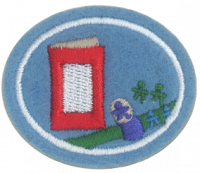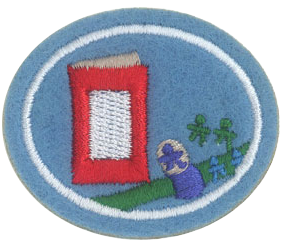Difference between revisions of "AY Honors/Card Making/Answer Key/es"
(Created page with "{{clear}}") |
(Created page with "</noinclude> <!-- 6. ¿Qué es arte en esponja y cómo se usa en hacer tarjetas? -->") |
||
| Line 84: | Line 84: | ||
{{CloseReq}} <!-- 2 --> | {{CloseReq}} <!-- 2 --> | ||
{{ansreq|page={{#titleparts:{{PAGENAME}}|2|1}}|num=3}} | {{ansreq|page={{#titleparts:{{PAGENAME}}|2|1}}|num=3}} | ||
| − | <noinclude></noinclude> | + | <noinclude></noinclude> |
| + | <!-- 3. Nombrar cuatro diferentes clases de almohadillas de tinta y describir cómo se usan. Mostrar competencia en usar por lo menos dos de ellas en un proyecto. --> | ||
{{clear}} | {{clear}} | ||
| Line 99: | Line 100: | ||
{{CloseReq}} <!-- 3 --> | {{CloseReq}} <!-- 3 --> | ||
{{ansreq|page={{#titleparts:{{PAGENAME}}|2|1}}|num=4}} | {{ansreq|page={{#titleparts:{{PAGENAME}}|2|1}}|num=4}} | ||
| − | <noinclude> | + | <noinclude></noinclude> |
| − | </noinclude> | + | <!-- 4. Describir cuatro métodos de colorear una imagen estampada y demostrar por lo menos dos de ellos. --> |
| − | <!-- 4. | ||
| − | |||
| − | |||
| − | |||
| − | |||
| − | |||
<div lang="en" dir="ltr" class="mw-content-ltr"> | <div lang="en" dir="ltr" class="mw-content-ltr"> | ||
| Line 113: | Line 108: | ||
{{CloseReq}} <!-- 4 --> | {{CloseReq}} <!-- 4 --> | ||
{{ansreq|page={{#titleparts:{{PAGENAME}}|2|1}}|num=5}} | {{ansreq|page={{#titleparts:{{PAGENAME}}|2|1}}|num=5}} | ||
| − | <noinclude> | + | <noinclude></noinclude> |
| − | </noinclude> | + | <!-- 5. ¿Qué significa el término monocromático? --> |
| − | <!-- 5. | ||
| − | |||
| − | |||
| − | + | <noinclude></noinclude> | |
| − | <noinclude | ||
| − | |||
{{CloseReq}} <!-- 5 --> | {{CloseReq}} <!-- 5 --> | ||
{{ansreq|page={{#titleparts:{{PAGENAME}}|2|1}}|num=6}} | {{ansreq|page={{#titleparts:{{PAGENAME}}|2|1}}|num=6}} | ||
| − | <noinclude> | + | <noinclude></noinclude> |
| − | </noinclude> | + | <!-- 6. ¿Qué es arte en esponja y cómo se usa en hacer tarjetas? --> |
| − | <!-- 6. | ||
| − | |||
| − | |||
| − | + | <noinclude></noinclude> | |
| − | <noinclude | ||
| − | |||
{{CloseReq}} <!-- 6 --> | {{CloseReq}} <!-- 6 --> | ||
{{ansreq|page={{#titleparts:{{PAGENAME}}|2|1}}|num=7}} | {{ansreq|page={{#titleparts:{{PAGENAME}}|2|1}}|num=7}} | ||
| − | <noinclude> | + | <noinclude></noinclude> |
| − | </noinclude> | + | <!-- 7. ¿Qué es repujar y qué materiales son necesarias para esta técnica? --> |
| − | <!-- 7. | ||
| − | |||
| − | |||
| − | + | {{clear}} | |
| − | |||
| − | |||
| − | |||
| − | |||
| − | |||
| − | |||
| − | + | {{clear}} | |
| − | |||
| − | |||
| − | + | <noinclude></noinclude> | |
| − | <noinclude | ||
| − | |||
{{CloseReq}} <!-- 7 --> | {{CloseReq}} <!-- 7 --> | ||
{{ansreq|page={{#titleparts:{{PAGENAME}}|2|1}}|num=8}} | {{ansreq|page={{#titleparts:{{PAGENAME}}|2|1}}|num=8}} | ||
| − | <noinclude> | + | <noinclude></noinclude> |
| − | </noinclude> | + | <!-- 8. Mostrar el cuidado y la limpieza apropiada de sellos de goma y el almacenamiento apropiado de almohadillas de tinta. --> |
| − | <!-- 8. | ||
| − | |||
<div lang="en" dir="ltr" class="mw-content-ltr"> | <div lang="en" dir="ltr" class="mw-content-ltr"> | ||
Revision as of 14:44, 26 April 2021
Nivel de destreza
1
Año
2010
Version
27.10.2025
Autoridad de aprobación
Asociación General
1
1a
1b
1c
1d
1e
1f
1g
1h
2
2a
2b
2c
2d
2e
2f
3
4
5
6
7
8
In the club we set up a rubber stamp care station for kids to demonstrate cleaning the stamps they used during our card making time.
FOR CLEANING STAMPS, you will need: a roll of Paper Towels (Viva brand is great because it doesn't leave tiny fibers) a spray bottle with water a spray bottle with gentle detergent or dish soap diluted with lots of water a couple of trays lined with paper towels for drying & catching excess water
FOR STORING INK PADS, you will need to decide what your storage unit of choice will be. Here are some options:
- deep cleanex box, cut out a portion of the box so you can stand on its side (lengthwise, like a tower)& easily stack ink pads in.
- old cassette organizer/shelf (thrift stores might still have em!)
- fancy, expensive store bought shelves
- DIY inkpad foam holder -- there are several patterns and designs online, most use foam boards that you cut and glue to make shelves.
Depending on your ink type, you may want to explain that some folks turn their pads upside down so that the ink will stay closest to the top of the sponges and are ready to use right away. PIGMENT and sloppy inks are better left right-side up so they don't drip on to the lids. the key is ALWAYS --
(1) KEEP YOUR PADS LIDS ON; (2) lay your pads FLAT so the ink doesn't run around and smudge (esp. on rainbow and multiple colored pads).
9
THESE ARE DIFFERENT TYPES OF ADHESIVES or "Stick-em on"-ers. There are tons of adhesive options out there that have various effects on your cards dimensions & embellishments.
9a
lifts embellishments you are sticking on so they "pop up"
9b
SIMILAR TO FOAM DOTS but can be for bigger items, lifts embellishments you are sticking on so they "pop up"
9c
Flat adhesive, great for photos and thin or lightweight embellishments. Best method for attaching ribbon to cards.
9d
great for boarders and for adhering two sheets together
9e
invisible way to stick embellishments and hold sheets together
9f
-a decorative way to adhere things to cards because of the varieties on patterns and designs -can also be used for trimmings and boarders
10
11
11a
11b
11c
11d
11e
11f
See guide to each technique above
12
12a
12b
The most enjoyable part of making cards is giving them away, so go bless some people. If you create 5 postcards and send them, you also fulfill one of the practical requirements of the Postcards - Advanced honor.
13
"So, my brothers and sisters, be strong and stead, always enthusiastic about the Lord's work, for you know that nothing you do for the Lord is ever useless." -- much like an encouragement card or a morale booster
13b
"Final Greetings: Tychicus, a much loved brother and faithful helper in the Lord's work, will tell you all about how I am getting along." In biblical days letters were hand delivered and often read to or sometimes recited word for word to the recipient (much like singing tele-grams!). Here is an example of how Paul doesn't even bother to tell his readers how he is and lets his messenger do it! Our modern day cards are usually how folks update each other on the latest happenings in each others lives.
"Greetings from Paul: This letter is from Paul and Timothy, slaves of Jesus Christ." This resembles a letterhead on a formal letter where you write the address and position of the writer. We usually don't need to add our titles on to greeting cards unless it is an official or business correspondence.
"So, don't be misled, my brothers and sisters...be quick to listen, slow to speak, and slow to get angry." This passage from Paul gives us advice on how to act or re-act. Not many cards actually give sound advice these days, usually if and when a card gives advice its out of humor.
13e
"This letter is from Paul, in prison for preaching the Good News about Christ Jesus, and from our brother Timothy." Paul signs his name and identifies who wrote it at the BEGINNING of his letters & ends with his wishes and prayers for the reader. Traditionally, we sign our cards at the bottom or end of the message & place greetings/blessings/well-wishes at the front.
References
contributor: ArniLynne Tupas-Setser, New Hope SDA Nighthawks, 2014.


